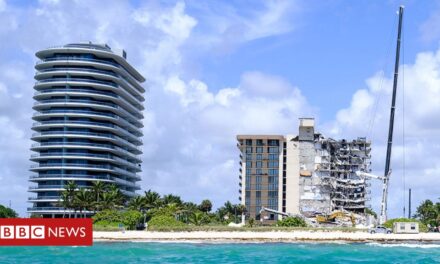
Major Earthquake Shakes Acapulco and Mexico City


MEXICO CITY — A 7.1 magnitude earthquake struck near the port city of Acapulco Tuesday night, Mexico’s seismological agency said, shaking the capital, Mexico City, more than 230 miles away. At least one person was killed as a result of the quake, the authorities said.
Mexico’s national seismological service said the quake struck seven miles southwest of Acapulco just before 9 p.m. local time. Photos shared on social media showed cracked and damaged buildings, fallen lamp posts and streets strewn with broken glass in Acapulco.
The civil protection agency for Guerrero state, home to Acapulco, said the quake had led to power and phone outages. Videos from both Acapulco and Mexico City also showed the night sky lit up with electrical flashes as power lines swayed and buckled.
The Federal Electricity Commission said that 1.6 million users were left without power in Mexico City and the states of Mexico, Guerrero, Oaxaca and Morelos.
In the capital, power lines and buildings swayed for several seconds, and residents rushed outside to seek clear ground. Some neighborhoods in Mexico City were left without power, the police said.
In an interview with a local radio station, Hector Astudillo, the governor of Guerrero state, said that one person had died when a post fell on top of them in the municipality de Coyuca de Benítez, west of Acapulco.
Mr. Astudillo added that there had been reports of rocks falling and land sliding, and that walls had fallen down in Chilpancingo, the state’s capital. Many parts of Acapulco were without power late Tuesday evening. “We are trying to continue gathering the information,” the governor said.
A representative for the Red Cross in Chilpancingo said it had received no reports of serious injuries.
The U.S. tsunami warning system issued a warning for Mexico, though the civil protection office for Guerrero state said later that there was no risk of a tsunami. Waves, it said, were expected to be below three feet in height.
The United States Geological Survey said the quake, which it measured at 7.0, was very shallow, only 7.8 miles below the surface, which would have amplified the shaking effect.
However, authorities across Mexico said the immediate effects of the quake on infrastructure had been limited.
“There are no serious damages,” President Andrés Manuel López Obrador said in a video posted to Twitter at about 11 p.m. Eastern time, adding that he had spoken to state and local authorities in the affected areas.
The mayor of Mexico City, Claudia Sheinbaum, said that the capital’s subway system was back up and running after services were briefly shut down because of the quake. A newly installed cable car in the working-class neighborhood of Iztapalapa, which could be seen swaying violently during the quake in videos shared online, was also back in service, Ms. Sheibaum said.
The federal electricity commission was working to restore power to neighborhoods that had gone dark because of the quake, the mayor added.
Mexico is no stranger to earthquakes, with residents in the capital accustomed to regular, and occasionally deadly, seismic activity thanks to the country’s position near colliding sections of the earth’s crust.
Last year, a 7.5 magnitude earthquake struck the Pacific coast of Mexico and shook the rural state of Oaxaca, killing at least six people and damaging some 500 homes. This followed a devastating quake in 2017, which toppled buildings and left scores dead, including children who were buried under a collapsed school.
Still, Mexican authorities have improved construction codes and warning systems significantly since the devastating earthquake in 1985 that killed as many as 10,000 people in the Mexican capital, greatly reducing the risks of damage.
The capital’s earthquake warning system appeared to have functioned effectively, with speakers across the city issuing a loud siren and a spoken warning of the quake several seconds before it happened, prompting many to rush outside.
At least one person has died after an earthquake was reported near Acapulco, the governor of the state of Guerrero, where the quake was located, said.
In an interview with a local radio station, Héctor Astudillo, the governor, said that one person had died during the quake. He said a post fell on top of the person in the town of Coyuca de Benítez, west of Acapulco.
Mr. Astudillo added that there have been reports of rocks and soil falling, and that walls had fallen down in Chilpancingo, the state’s capital. Many parts of Acapulco remained without power late Tuesday evening. “We are trying to continue gathering information,” the governor said.

Septembers have not historically been kind to Mexico.
The 7.1 magnitude earthquake that was felt in Mexico City on Tuesday recalls some of the powerful temblors to have affected the city.
A huge 8.1 magnitude earthquake killed as many as 10,000 people on Sept. 19, 1985, flattening or seriously damaging thousands of buildings and leading the country to upgrade its construction codes.
On the 32nd anniversary of that earthquake, another one centered about 100 miles southeast rocked the city, killing more than 155 people, including dozens of children inside a schoolAlberto Briseño, a 58-year-old bar manager, said at the time, “The scariest part of it all is that if you are an adult, and you’ve lived in this city your adult life, you remember 1985 very vividly.”
Tuesday’s earthquake came on the same day in 2017 when another earthquake killed nearly 100 people and damaged more than 153,000 homes in the southern states of Oaxaca and Chiapas.
Mexico is in an area prone to powerful earthquakes, known as a subduction zone. Those are parts of the earth where one slab of the crust is slowly sliding under another. Over time, stress builds because of friction between the slabs. Eventually, the strain becomes so great that all the pent-up energy is released in the form of an earthquake.
In the last century, there have been 17 earthquakes of a magnitude of 7.0 within 150 miles of Tuesday night’s quake, the U.S. Geological Survey said.

The scene in Mexico City’s Roma Norte neighborhood was a familiar one after Tuesday’s quake: Bar patrons and residents huddled in groups in the streets, texting and calling their friends and families.
The historic neighborhood, known for its colonial architecture and popularity among artists, sits on an ancient lake bed that was long ago filled in. The silty soil amplifies a quake’s energy, making the neighborhood at particular risk for damage during strong earthquakes.
In 2017, when a powerful earthquake struck Mexico, an office building collapsed in Roma Norte and rescuers scrambled to save people caught in the rubble.
Tuesday’s quake forced patrons of restaurants and bars into the streets. At one point, the earth swayed and power lines buckled, setting off firework-like explosions that lit up the night sky. Restaurants and bars kept patrons outside for at least 30 minutes, then allowed them back in.
Some residents said the quake reminded them of the 2017 disaster, in which hundreds of people died and thousands more were injured.
“We were really scared,” said Ricardo Galvan, who was having a drink Tuesday after the quake with his friends at a bar in the Roma Norte neighborhood. He experienced the deadly 2017 temblor. “I thought it was the same,” he said.
He and his friends rushed out into the street, where they saw two buildings sway and collide.
“It was shaking for a while,” said Mr. Galvan’s friend, Nanae Watabe. She said many are still traumatized by the 2017 quake.
“We were standing right in front of a building that had been torn down after the 2017 earthquake,” she said, indicating her location during Tuesday’s event. The earthquake siren was “ingrained” in her mind, she said, adding, “It’s horrible.”
Mercedes Bernal, who runs a restaurant in Roma Norte, said that she was in exactly the same spot when the devastating quake hit in 2017. Though the shaking felt similar, she said, she was comforted by messages from the city’s mayor this time assuring residents that the worst had passed. One death was reported from the Tuesday quake.
“They all kind of feel the same no matter if they’re deadly or not,” Ms. Bernal said, adding that when the siren sounded, she and her team had switched off the gas to avoid an explosion and had quickly evacuated a full house of 45 diners.
Some hours later, Ms. Bernal said she had been debating whether to serve people again, and had decided that it was safe to do so.
“A little mezcal,” she added, could help to cure “the fright.”
-

Acapulco Francisco Robles/Agence France-Presse — Getty Images
-

Mexico City Rodrigo Arangua/Agence France-Presse — Getty Images
-

Mexico City Jose Mendez/EPA, via Shutterstock
-

Mexico City Tomas Bravo/Reuters
-

Acapulco Francisco Robles/Agence France-Presse — Getty Images
-

Mexico City Rodrigo Arangua/Agence France-Presse — Getty Images
-

Acapulco Francisco Robles/Agence France-Presse — Getty Images
A 7.1 magnitude earthquake hit the Mexican beach city of Acapulco and was felt as far away as the capital, shaking buildings and sending residents to the streets. Here are some pictures from the immediate aftermath of the quake.

Shaking streets and strobing lights were seen in parts of Mexico City and Acapulco, followed by darkness after a strong earthquake cut power late Tuesday.
Much of the damage was to power grids, while some homes sustained minor damage. The Federal Electricity Commission Tuesday that 1.6 million users were left without power in Mexico City and the states of Mexico, Guerrero, Oaxaca and Morelos.
Videos from both Acapulco and Mexico City also showed the night sky lit up with electrical flashes as power lines swayed and buckled.
Mayor Claudia Sheinbaum, of Mexico City, posted a video of herself at the city’s emergency response center, saying that power had come back to some parts of the city. She tweeted that the city’s cable car resumed service after it had shut down.
One video showed a group stuck in one of the cable cars as the earthquake started.
“Relax, relax,” a man can be heard saying in the video. “No pasa nada, no pasa nada,” another said reassuring an older woman who was praying that nothing would happen.
But mostly, neighborhoods are waiting for power to come back.

The large quake that hit Mexico late Tuesday was strong and shallow, the U.S. Geological Survey said.
The quake was centered about 10 miles northeast of Acapulco and was only 12 miles deep, magnifying its strength and helping ensure it was felt as far away as Veracruz. A tsunami alert was issued for the coast and then rescinded a short time later.
The U.S.G.S. said the quake was caused by a shallow thrust “on or near” the plate boundary between the oceanic Cocos plate and North America’s continental plate. The Cocos plate is gradually sinking beneath the North American plate.
Strong earthquakes on or near the coast are often felt in Mexico City because the capital was built on an ancient lake bed that has been filled in, magnifying a quake’s energy.
— Traci Carl
Source: https://www.nytimes.com/live/2021/09/07/world/mexico-earthquake/

















